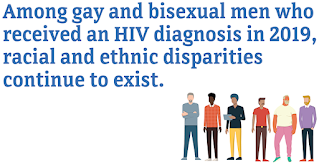HIV impacts the LGBTQ+ community compared to others
 According to the CDC In the United States, there are 1.2 million people living with HIV, and about 40,000 persons were diagnosed with HIV in 2015. Between 2005 and 2014, the yearly number of new diagnoses decreased by 19%, however, improvement has been inconsistent. For example, gay and bisexual males made up around 2% of the US total population in 2019, yet they accounted for 69% of all HIV-positive people in the country. If present rates of HIV diagnosis continue, one out of every six homosexual and bisexual males will be diagnosed with the virus throughout their lifetime. The percentages of Latino and Black males who are gay or bisexual are 1 in 4 and 1 in 2, respectively.
According to the CDC In the United States, there are 1.2 million people living with HIV, and about 40,000 persons were diagnosed with HIV in 2015. Between 2005 and 2014, the yearly number of new diagnoses decreased by 19%, however, improvement has been inconsistent. For example, gay and bisexual males made up around 2% of the US total population in 2019, yet they accounted for 69% of all HIV-positive people in the country. If present rates of HIV diagnosis continue, one out of every six homosexual and bisexual males will be diagnosed with the virus throughout their lifetime. The percentages of Latino and Black males who are gay or bisexual are 1 in 4 and 1 in 2, respectively.
Hiv treatment is underfunded.

Overview
In the United States and across the world, HIV is a severe public health crisis. Despite the fact that huge scientific discoveries have rendered it simpler than ever before to prevent or treat HIV, there is still no vaccine or cure, and thousands of individuals develop HIV each year. Inadequate financing for public health initiatives, ideological hostility to good judgment preventative strategies, and cultural hurdles such as shame and prejudice have made it particularly difficult to stem the flow of the pandemic.
References:
“HIV and All Gay and Bisexual Men.” Centers for Disease Control and Prevention, Centers for Disease Control and Prevention, 16 Sept. 2021, https://www.cdc.gov/hiv/group/msm/index.html.
“HIV and the LGBTQ Community.” Human Rights Campaign, https://www.hrc.org/resources/hrc-issue-brief-hiv-aids-and-the-lgbt-community.







No comments:
Post a Comment